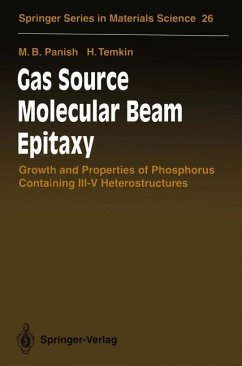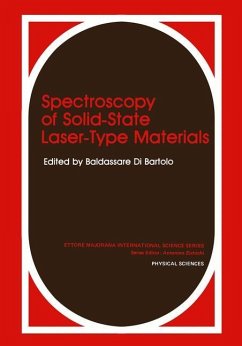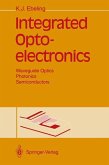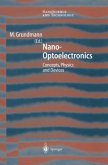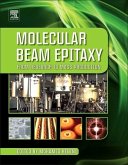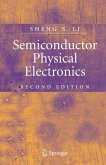Morton B. Panish, Henryk Temkin
Gas Source Molecular Beam Epitaxy
Growth and Properties of Phosphorus Containing III-V Heterostructures
Morton B. Panish, Henryk Temkin
Gas Source Molecular Beam Epitaxy
Growth and Properties of Phosphorus Containing III-V Heterostructures
- Broschiertes Buch
- Merkliste
- Auf die Merkliste
- Bewerten Bewerten
- Teilen
- Produkt teilen
- Produkterinnerung
- Produkterinnerung
The first book to present a unified treatment of hybrid source MBE and metalorganic MBE. Since metalorganic MBE permits selective area growth, the latest information on its application to the INP/GaInAs(P) system is presented. This system has been highlighted because it is one of rising importance, vital to optical communications systems, and has great potential for future ultra-highspeed electronics. The use of such analytical methods as high resolution x-ray diffraction, secondary ion mass spectroscopy, several photoluminescence methods, and the use of active devices for materials evaluation is shown in detail.…mehr
Andere Kunden interessierten sich auch für
![Spectroscopy of Solid-State Laser-Type Materials Spectroscopy of Solid-State Laser-Type Materials]() Baldassare Di BartoloSpectroscopy of Solid-State Laser-Type Materials83,99 €
Baldassare Di BartoloSpectroscopy of Solid-State Laser-Type Materials83,99 €![Optical Properties of Highly Transparent Solids Optical Properties of Highly Transparent Solids]() Bernard BendowOptical Properties of Highly Transparent Solids43,99 €
Bernard BendowOptical Properties of Highly Transparent Solids43,99 €![Integrated Optoelectronics Integrated Optoelectronics]() Karl J. EbelingIntegrated Optoelectronics81,99 €
Karl J. EbelingIntegrated Optoelectronics81,99 €![Nano-Optoelectronics Nano-Optoelectronics]() Nano-Optoelectronics125,99 €
Nano-Optoelectronics125,99 €![Molecular Beam Epitaxy Molecular Beam Epitaxy]() Molecular Beam Epitaxy252,99 €
Molecular Beam Epitaxy252,99 €![Semiconductor Physical Electronics Semiconductor Physical Electronics]() Sheng S. LiSemiconductor Physical Electronics166,99 €
Sheng S. LiSemiconductor Physical Electronics166,99 €![Electrical Characterization of ZnO thin films grown by molecular beam epitaxy Electrical Characterization of ZnO thin films grown by molecular beam epitaxy]() Vladimir PetukhovElectrical Characterization of ZnO thin films grown by molecular beam epitaxy18,00 €
Vladimir PetukhovElectrical Characterization of ZnO thin films grown by molecular beam epitaxy18,00 €-
-
-
The first book to present a unified treatment of hybrid source MBE and metalorganic MBE. Since metalorganic MBE permits selective area growth, the latest information on its application to the INP/GaInAs(P) system is presented. This system has been highlighted because it is one of rising importance, vital to optical communications systems, and has great potential for future ultra-highspeed electronics. The use of such analytical methods as high resolution x-ray diffraction, secondary ion mass spectroscopy, several photoluminescence methods, and the use of active devices for materials evaluation is shown in detail.
Hinweis: Dieser Artikel kann nur an eine deutsche Lieferadresse ausgeliefert werden.
Hinweis: Dieser Artikel kann nur an eine deutsche Lieferadresse ausgeliefert werden.
Produktdetails
- Produktdetails
- Springer Series in Materials Science .26
- Verlag: Springer / Springer Berlin Heidelberg / Springer, Berlin
- Artikelnr. des Verlages: 978-3-642-78129-2
- Softcover reprint of the original 1st ed. 1993
- Seitenzahl: 444
- Erscheinungstermin: 30. Dezember 2011
- Englisch
- Abmessung: 235mm x 155mm x 24mm
- Gewicht: 688g
- ISBN-13: 9783642781292
- ISBN-10: 3642781292
- Artikelnr.: 36120675
- Herstellerkennzeichnung Die Herstellerinformationen sind derzeit nicht verfügbar.
- Springer Series in Materials Science .26
- Verlag: Springer / Springer Berlin Heidelberg / Springer, Berlin
- Artikelnr. des Verlages: 978-3-642-78129-2
- Softcover reprint of the original 1st ed. 1993
- Seitenzahl: 444
- Erscheinungstermin: 30. Dezember 2011
- Englisch
- Abmessung: 235mm x 155mm x 24mm
- Gewicht: 688g
- ISBN-13: 9783642781292
- ISBN-10: 3642781292
- Artikelnr.: 36120675
- Herstellerkennzeichnung Die Herstellerinformationen sind derzeit nicht verfügbar.
1. Introduction.- 1.1 Introduction to Molecular Beam Epitaxy.- 1.2 Introduction to Gas Source Molecular Beam Epitaxy.- 1.3 Why Gas Sources?.- 1.4 Heterostructures with GSMBE.- 2. Chemistry.- 2.1 Equilibrium, the Phase Diagram, and Molecular Beam Epitaxy.- 2.2 Liquid-Solid-Vapor Relationships for the Growth of InP and GaAs.- 2.3 III-V Solid Solutions.- 2.4 Group III Metalorganics - Metalorganic MBE.- 2.5 Group V Metalorganics to Replace Arsine and Phosphine.- 3. The Generation of Atomic and Molecular Beams for Elemental and Gas Source Molecular Beam Epitaxy.- 3.1 Background.- 3.2 Molecular Effusion: The Ideal Effusion Cell.- 3.3 Real Effusion Cells.- 3.4 Gas Sources and Their Use in GSMBE.- 3.5 Introduction of the Group III Metalorganics into the MBE System.- 4. Molecular Beam Epitaxy Systems and Procedures.- 4.1 The Conventional Growth Chamber-Configuration for ESMBE, HSMBE and MOMBE.- 4.2 System Pressure - Pumping.- 4.3 Sample Introduction, Transfer and Manipulation.- 4.4 Substrate Temperature Measurement and Control.- 4.5 Gas Handling.- 4.6 Arsine and Phosphine Generators.- 4.7 Safe Handling of Arsine and Phosphine for GSMBE.- 4.8 Procedures for GSMBE.- 4.9 The RHEED Apparatus, Growth Rate and Composition Calibration.- 4.10 Metalorganic MBE Systems - Potential for Scaleup.- 5. Doping During GSMBE.- 5.1 Background.- 5.2 Maximum Free-Carrier Concentrations in Semiconductors.- 5.3 Background Doping and Carbon Incorporation.- 5.4 Doping with Tin.- 5.5 Doping with Be.- 5.6 Zn in InP and GaInAs.- 5.7 Si in GaAs, InP and GaInAs.- 5.8 Semi-insulating InP by Fe Doping During MBE.- 6. Characterization of Heterostructures by High Resolution X-ray Diffraction.- 6.1 X-Ray Diffraction of Epitaxial Layers.- 6.2 Periodic Epitaxial Semiconductor Structures.- 6.3 High-ResolutionX-Ray Diffraction.- 6.4 High-Resolution Rocking Curves of Superlattices.- 6.5 Intrinsic Strain at Heterostructure Interfaces.- 7. Optical Properties of Quantum Wells.- 7.1 Energy Levels in Quantum Wells.- 7.2 Single Quantum Wells.- 7.3 Superlattices.- 7.4 Quantum Wires and Boxes.- 7.5 Electric Field Effects.- 7.6 Strained-Layer Superlattices.- 7.7 Thermal Stability.- 8. Carrier Transport Across Quantum Wells and Superlattices.- 8.1 Experimental Techniques.- 8.2 Motion of Photo-Induced Holes.- 8.3 Sequential Screening.- 8.4 Barrier Height.- 8.5 Heterojunction Band Offsets.- 8.6 Telegraph Noise.- 9. Bipolar Transistors.- 9.1 Background.- 9.2 Figures of Merit.- 9.3 Device Fabrication.- 9.4 DC Characteristics.- 9.5 Temperature Dependence.- 9.6 Carrier Transport.- 9.7 Gain Dependence on the Base Thickness.- 9.8 Microwave Devices.- 9.9 Applications.- 10. Optoelectronic Devices.- 10.1 Broad-Area Lasers.- 10.2 Buried Heterostructure Lasers.- 10.3 Single-Frequency Lasers.- 10.4 Visible Lasers.- 10.5 Photodetectors.- 10.6 Quantum-Well Inter-sub-band Detectors.- 11. In-Situ Processing and Selective Area Epitaxy.- 11.1 Pattern Formation.- 11.2 Ion-Induced Damage.- 11.3 Towards Vacuum Lithography.- 11.4 Buried Heterostructures.- 11.5 Selective-Area Epitaxy.- References.
1. Introduction.- 1.1 Introduction to Molecular Beam Epitaxy.- 1.2 Introduction to Gas Source Molecular Beam Epitaxy.- 1.3 Why Gas Sources?.- 1.4 Heterostructures with GSMBE.- 2. Chemistry.- 2.1 Equilibrium, the Phase Diagram, and Molecular Beam Epitaxy.- 2.2 Liquid-Solid-Vapor Relationships for the Growth of InP and GaAs.- 2.3 III-V Solid Solutions.- 2.4 Group III Metalorganics - Metalorganic MBE.- 2.5 Group V Metalorganics to Replace Arsine and Phosphine.- 3. The Generation of Atomic and Molecular Beams for Elemental and Gas Source Molecular Beam Epitaxy.- 3.1 Background.- 3.2 Molecular Effusion: The Ideal Effusion Cell.- 3.3 Real Effusion Cells.- 3.4 Gas Sources and Their Use in GSMBE.- 3.5 Introduction of the Group III Metalorganics into the MBE System.- 4. Molecular Beam Epitaxy Systems and Procedures.- 4.1 The Conventional Growth Chamber-Configuration for ESMBE, HSMBE and MOMBE.- 4.2 System Pressure - Pumping.- 4.3 Sample Introduction, Transfer and Manipulation.- 4.4 Substrate Temperature Measurement and Control.- 4.5 Gas Handling.- 4.6 Arsine and Phosphine Generators.- 4.7 Safe Handling of Arsine and Phosphine for GSMBE.- 4.8 Procedures for GSMBE.- 4.9 The RHEED Apparatus, Growth Rate and Composition Calibration.- 4.10 Metalorganic MBE Systems - Potential for Scaleup.- 5. Doping During GSMBE.- 5.1 Background.- 5.2 Maximum Free-Carrier Concentrations in Semiconductors.- 5.3 Background Doping and Carbon Incorporation.- 5.4 Doping with Tin.- 5.5 Doping with Be.- 5.6 Zn in InP and GaInAs.- 5.7 Si in GaAs, InP and GaInAs.- 5.8 Semi-insulating InP by Fe Doping During MBE.- 6. Characterization of Heterostructures by High Resolution X-ray Diffraction.- 6.1 X-Ray Diffraction of Epitaxial Layers.- 6.2 Periodic Epitaxial Semiconductor Structures.- 6.3 High-ResolutionX-Ray Diffraction.- 6.4 High-Resolution Rocking Curves of Superlattices.- 6.5 Intrinsic Strain at Heterostructure Interfaces.- 7. Optical Properties of Quantum Wells.- 7.1 Energy Levels in Quantum Wells.- 7.2 Single Quantum Wells.- 7.3 Superlattices.- 7.4 Quantum Wires and Boxes.- 7.5 Electric Field Effects.- 7.6 Strained-Layer Superlattices.- 7.7 Thermal Stability.- 8. Carrier Transport Across Quantum Wells and Superlattices.- 8.1 Experimental Techniques.- 8.2 Motion of Photo-Induced Holes.- 8.3 Sequential Screening.- 8.4 Barrier Height.- 8.5 Heterojunction Band Offsets.- 8.6 Telegraph Noise.- 9. Bipolar Transistors.- 9.1 Background.- 9.2 Figures of Merit.- 9.3 Device Fabrication.- 9.4 DC Characteristics.- 9.5 Temperature Dependence.- 9.6 Carrier Transport.- 9.7 Gain Dependence on the Base Thickness.- 9.8 Microwave Devices.- 9.9 Applications.- 10. Optoelectronic Devices.- 10.1 Broad-Area Lasers.- 10.2 Buried Heterostructure Lasers.- 10.3 Single-Frequency Lasers.- 10.4 Visible Lasers.- 10.5 Photodetectors.- 10.6 Quantum-Well Inter-sub-band Detectors.- 11. In-Situ Processing and Selective Area Epitaxy.- 11.1 Pattern Formation.- 11.2 Ion-Induced Damage.- 11.3 Towards Vacuum Lithography.- 11.4 Buried Heterostructures.- 11.5 Selective-Area Epitaxy.- References.

